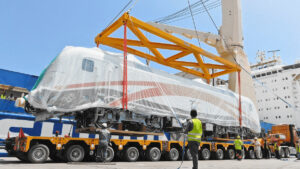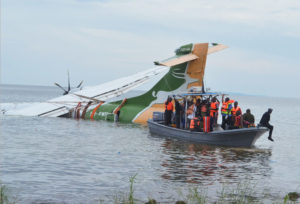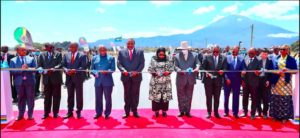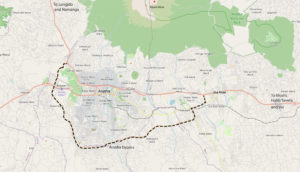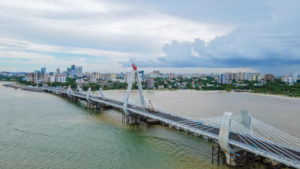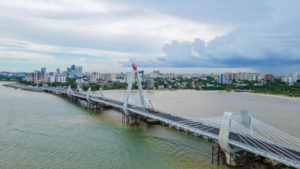by Ben Taylor
TAZARA upgrade (and privatisation?) on the cards
Tanzania, China, and Zambia have signed a significant agreement aimed at upgrading the Tanzania-Zambia Railway Authority (TAZARA) railway. The signing ceremony took place at the Great Hall of the People in Beijing in September and was witnessed by President Samia Suluhu Hassan of Tanzania, President Xi Jinping of China, and President Hakainde Hichilema from Zambia.
It was not stated how much the project will cost or the financing modality, but China in February proposed spending $1 billion to rehabilitate the rail line through a public-private partnership model.
The Memorandum of Understanding anticipates that rehabilitation of infrastructure and rolling stock would take two years, and in the longer term traffic would increase from 0·5 million to approximately 2 million metric tonnes per year. “China is willing to take this summit as an opportunity to make new progress in the revitalisation of the Tanzania-Zambia railway, cooperate to improve the rail-sea intermodal transport network in East Africa, and build Tanzania into a demonstration zone for deepening high-quality China-Africa Belt and Road cooperation,” President Xi said.
The decision to upgrade the TAZARA railway comes at a time when regional trade between Southern and East Africa is becoming increasingly important. The improvements are expected to boost trade and economic cooperation not only between Tanzania and Zambia but also with China, which has been a key partner in the development of African infrastructure.
Later, speaking at the Joint Transport Sector Review, held in Arusha in October, the Minister for Transport Prof Makame Mbarawa, said that the government is in the process of transferring the operation of the Tanzania-Zambia Railway Authority (TAZARA) to the private sector to improve its efficiency and boost performance in the transportation of cargo.
He urged both domestic and foreign private entities capable of providing wagons and engines to seize the opportunity to utilise the railway for a special access fee.
“Now that the laws, rules and the policy have changed, our next step is to inform private sector stakeholders to submit their applications for this operational opportunity on our railways,” said Prof Mbarawa. “We have already identified a Chinese company and on September 5 we signed an MoU in China between the governments of Tanzania, Zambia and the designated Chinese company. We are currently discussing leasing terms, costs, duration and other concession details,” he explained. He added that their aim was to complete this process by the end of 2024.
Elsewhere, it was reported that the China Civil Engineering Construction Corp (CCECC) is in active negotiations for a 30-year concession to operate the Tanzania-Zambia Railway network and revitalise the infrastructure and rolling stock. CCECC built the Chinese-funded line in the 1970s, and recently undertook a comprehensive business and technical inspection of the network.
Separately, earlier in 2024, the World Bank approved a USD$270mn grant to support improvements in transport and trade connectivity between Zambia, Tanzania and Southern Africa. According to the World Bank, the money will be used to rehabilitate a portion of the TAZARA in Zambia, develop a modern border post between Zambia and Tanzania and introduce other supporting infrastructure. (Daily News, The Citizen)
SGR celebrated, but faces teething troubles
The much-acclaimed upgrade to the rail line connecting Dar es Salaam with Dodoma – and beyond – which began operations earlier in 2024, has encountered some significant operational challenges.
In early November, a temporary maintenance issue halted trains, leaving hundreds of passengers stranded for several hours while a technical team addressed the problem. TRC (Tanzania Rail Corporation) issued a statement informing passengers of the temporary disruption and apologised for the inconvenience caused by the operational fault.
The potential and advantages of the upgraded and electrified line is clear, not least in the rapid 3-hour journey time between Dar and Dodoma – making the journey much quicker than buses (typically 7 hours) and cheaper than flights.
“It is awesome,” said one passenger. “You cannot compare it with the old train: it’s convenient, it’s clean, it’s easy.”
Machibya Masanja of TRC says at least 7,000 passengers travel on the eight daily services on the line, which is already approaching capacity. He told the BBC that the demand has been so high that “we cannot meet it with those trips we are making per day. We expect the number will double or triple.”
Since the SGR services launched between Dar es Salaam and Morogoro in June, and extended to Dodoma in August, TRC has reported collecting TSh 30bn from ticket sales as of November 30.
Further, TRC director of public operations, Mr Focus Sahani, said TRC was expecting to receive the first batch of 250 cargo wagons in December 2024, with plans for a total of 1,439 wagons to support the route from Dar es Salaam to Dodoma.
Some of that potential is undermined, however, according to reports from other customers that boarding takes as much as two hours due to “excessive” airline-style security measures. Complaints have also focussed on the banning of passengers taking their own food on the journey.
In recognition of another challenge, Tanzania Railways Corporation (TRC) has announced plans to import hybrid engines that run on both electricity and diesel to ensure uninterrupted operations of the Standard Gauge Railway (SGR) in the event of power outages. Earlier in the year, amid public concerns over electricity supply reliability, TRC Director General Masanja Kadogosa reassured Tanzanians that the electric trains would have a dedicated power system independent of the national grid, a design that minimises the risk of operational disruptions.
Further, TRC is intensifying efforts to safeguard the SGR infrastructure. Collaboration with law enforcement agencies has led to the arrest of multiple suspects involved in vandalism, though exact figures have not been disclosed. TRC also has plans to install CCTV cameras from Dar es Salaam to Dodoma. “Cameras have already been installed in high-risk areas, and the remaining installations will commence soon,” Mr Kadogosa noted.
Meanwhile, SGR railway construction is ongoing, with more phases under construction: from Tabora to Kigoma and aiming to connect to Rwanda, Burundi, and the Democratic Republic of Congo.
In a boost for the project, the African Development Bank (AfDB) has joined forces with Deutsche Bank and France’s Société Générale to spearhead a financing syndication strategy aimed at raising up to $1.2 billion for the section connecting Kigoma and Tabora. “We are excited to be part of this landmark project,” said Deutsche Bank’s Managing Director for Africa, Myriam Ouazzani. “The SGR will not only connect countries but will also spur job creation and promote regional economic integration.”
Hope for the upgraded remains high, though some doubts remain. “Let’s enjoy the SGR while it lasts,” wrote one commentator. “Revel in the gliding trains and the three-hour journeys. Reality is cruel: diesel engines will replace electric engines and this shiny new toy is going to get rusty. Very rusty.”
Air travel setbacks – and growth
In a setback for Air Tanzania’s growth prospects, the European Union has banned the airline from using EU airspace, citing safety concerns. The move is of no immediate practical significance as Air Tanzania does not operate any flights to the European Union.
According to the EU statement issued on December 13, 2024, Air Tanzania’s inclusion on the list stems from safety issues identified by the European Union Aviation Safety Agency (EASA).
Commenting on the ban, Tanzania’s chief government spokesperson, Gerson Msigwa, stated that ATCL was in talks with the EU to acquire landing slots in the EU Zone. Msigwa clarified that efforts are underway to obtain the necessary licensing for the national carrier to enter EU airspace, aligning with the bloc’s stringent aviation rules and regulations.
“The decision to include Air Tanzania in the EU Air Safety List underscores our unwavering commitment to ensuring the highest safety standards for passengers in Europe and worldwide,” said Apostolos Tzitzikostas, EU Commissioner for Sustainable Transport and Tourism. “We strongly urge Air Tanzania to take swift and decisive action to address these safety issues. I have offered the Commission’s assistance to the Tanzanian authorities in enhancing Air Tanzania’s safety performance and achieving full compliance with international aviation standards.”
In other news, the company had reason to celebrate, with the resumption of flights to South Africa following the resolution of a long-standing dispute. An Air Tanzania Airbus A220-300 had been impounded in Johannesburg, South Africa, following an order by the High Court of South Africa, amid a protracted legal battle between the Tanzanian government and retired farmer Hermanus Steyn. Details of the settlement that enabled the resumption of flights remain undisclosed.
TCL managing director Ladislaus Matindi said that the South African route will be a resounding success, driven by rising demand for travel between the two countries. “Many people view each country as a second home to the other, and as Tanzania’s national carrier, we feel that we are returning home,” he added.
Meanwhile, Air France announced a resumption of flights to Kilimanjaro International Airport after an absence of 28 years. Air France will operate three flights a week between KIA and Charles de Gaulle Airport in Paris. This is the latest expansion of Air France services to Tanzania, following their introduction of flights to Zanzibar twice a week via Nairobi since 2021 and direct flights from Paris to Dar es Salaam since 2023.

